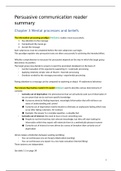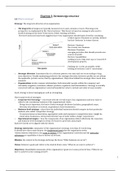Cooperating for Innovation - papers
Lecture 1 - Gulati (1998): Alliances and networks 1
Lecture 1 - Tsang (2000): Transaction cost and resource based explanations of
joint-ventures: a comparison and synthesis 6
Lecture 2 - Gassmann et al. (2010): Crossing the industry-line: breakthrough innovation
trough cross-industry alliances with ‘non-suppliers’ 12
Lecture 2 - Asgari et al. (2018): Creating and taming discord: how firms manage
embedded competition in alliance portfolios to limit alliance termination 15
Lecture 2 - Wuyts & Dutta (2014): Benefiting from alliance portfolio diversity: the role of
past internal knowledge creation strategy 18
Lecture 3 - Heimeriks et al. (2009): Building capabilities for alliance portfolios 21
Lecture 3 - Du et al. (2014): Managing open innovation projects with science-based and
market-based partners 25
Lecture 3 - Kapoor & Lee (2013): Coordinating and competing in ecosystems: how
organizational forms shape new technology investments 28
Lecture 4 - Oxley & Sampson (2004): The scope and governance of international R&D
alliances 31
Lecture 4 - Reuer & Devarakonda (2016): Mechanisms of hybrid governance:
administrative committees in non-equity alliances 36
Lecture 4 - Devarakonda & Reuer (2019): Safeguarding from the sharks: board
representation in minority equity partnerships 39
Lecture 5 - Wadhwa et al. (2017): The paradox of openness and value protection effect of
extramural R&D on innovative performance 42
Lecture 5 - Katila et al. (2008): Swimming with sharks: technology ventures, defense
mechanisms, and corporate relationships 48
Lecture 5 - Laursen & Salter (2013): The paradox of openness: appropriability, external
search and collaboration 52
Lecture 6 - Sampson (2007): R&D alliances and firm performance: The impact of
technological diversity and alliance organization on innovation 56
Lecture 6 - Hoehn-Weiss et al. (2017): Examining alliance portfolios beyond the dyads:
the relevance of redundancy and nonuniformity across and between partners 59
Lecture 6 - Lahiri & Narayanan (2013): Vertical integration, innovation, and alliance
portfolio size: implications for firm performance 64
, CFI papers
Lecture 1 - Gulati (1998): Alliances and networks
Introduction
Strategic alliances = voluntary agreements between firms involving exchange, sharing, or
codevelopment of products, technologies, or services.
Research questions about the development of alliances:
- Which firms enter alliances and whom do they choose as partners?
- What type of contracts do firms use to formalize the alliance?
- How do the alliance and the partners’ participation evolve over time?
Research questions about the performance consequences:
- What factors influence the success of alliances?
- What is the effect of alliances on the performance of firms entering them?
Social structure and the embeddedness of firm behavior
Economic action does not take place in a barren social context but, rather, is embedded in
social networks of relationships.
Social network = a set of nodes (persons, organizations) linked by a set of social relationships
of a specified type.
There have been 4 broad types of focus of prior research on the influence of social networks:
inequality, embedding, contagion and contingency.
- Research on inequality suggests how network connections can explain differences in
the resources available to individuals, groups, or organizations
- Research on embedding describes the institutions and identities from networks and how
they enable difficult transactions
- Research on contagion shows how networks can promote behavioral conformity by
serving as conduits for both technological and social information about organizational
activities, which in turn can influence the extent to which they adopt new innovations
- Research on contingency approaches suggests how social networks can moderate
key organizational processes
2 analytical approaches for examining the influence of social networks. The first emphasizes the
differential informational advantages bestowed by social networks. The second highlights the
control benefits actors can generate by being advantageously positioned within a social
network.
1. First approach (highlight the informational advantages social networks have):
Relational embeddedness: suggests that actors who are strongly tied to each other are likely
to develop a shared understanding of the utility of certain behavior, which influence their actions
→ Cohesive ties can be a unique source of information about the partner’s capabilities/reliability
1
, CFI papers
Structural embeddedness: focus on the informational role of the position an organization
occupies in the overall structure of the network
2. Second approach (highlights the control benefits for actors):
An actor in a social network can derive control advantages by being the one who is situated
between two other actors. This actor in the middle can create advantages for himself by playone
one player off against the other and brokering tension between the other players.
The informational advantages to firms from a social network can enable the creation of new
alliances by 3 distinct means: access, timing, and referrals (Burt, 1992):
- Access = information about current or potential partners as to their capabilities and
trustworthiness. An existing network can influence a firm’s choice of feasible partners
and its attractiveness to other firms as a partner.
- Timing = entails having informational benefits about potential partners at the right time,
which can be important when a firm seeking attractive partners must approach them at
the right time and preempt their seeking alliance elsewhere.
- Referrals = a firm’s existing partners may refer other firms to it for alliances or to enter
three-way partnerships.
→ Firms with more social capital will not only have access to information about a larger number
of alliances, but they may also be able to attract better partners who want to ally with them.
Key issues in alliances
1. The formation of alliances
Kogut (1988): motivations to form alliances:
1. Transaction costs resulting from small numbers bargaining
2. Strategic behavior that leads firms to tr to enhance their competitive positioning or
market power
3. A quest for organizational knowledge or learning that results when one or both partners
want to acquire some critical knowledge from the other or one partner wants to maintain
its capability while seeking another firm’s knowledge
Alliance behavior: who do you pick as a partner? → Resource dependency theory:
organizations enter partnerships when they perceive critical strategic interdependence with
other organizations in their environment, in which one organization has resources/capabilities
beneficial but not possessed by the other.
Strategic independence perspective: firms ally with those with whom they share the greatest
interdependence. Firms are driven to enter alliances with each other by critical strategic
interdependence.
However: alliance partnerships are considered risky, because it is unpredictable, there is a risk
of free-riding and opportunistic behavior and high costs.
2
, CFI papers
- Firms need information about the reliability of their partners
- Here social networks play a role: if a firm is faced with uncertainty about a partner, actors
adopt a more social orientation and resort to existing networks to discover information
and alleviate the risk of opportunism.
- The (social) embeddedness of firms in social networks can both restrict and enable the
alliances a firm enters
Structural embeddedness also influences the choice of partners in alliances.
- The status of an organization in the network affects its reputation and visibility. The
greater the reputation, the wider the organization’s access to sources of knowledge and
richer the collaborative experience, which makes it an attractive partner
- Particularly important in uncertain environments
Vertical alliances (firm - supplier): the longer the prior history between two firms, the more likely
they are to recreate these ties (social embeddedness).
The conditions of mutual economic advantage are necessary but not sufficient conditions for
the formation of an alliance between two firms. Eventually it is a firm’s social connections that
help it identify new alliance opportunities and choose partners with complementary assets.
2. Governance structure of alliances
Joint ventures = partners creating a new entity in which they share equity and which most
closely replicate the hierarchical control features of organizations
Alliances = no share of equity and few hierarchical controls built in them
→ The greater the appropriation concerns, the more hierarchical the governance structures for
organizing the alliance are likely to be
An important implication of the embeddedness of firms in social networks is the enhanced trust
between firms.
Trust between firms = the confidence that a partner will not exploit the vulnerability of the
other. In social networks, trust can be promoted through 2 means:
1. Social networks can serve as effective referral networks
2. Social networks can serve as an important basis for enforceable or deterrence=based
trust. Each partner’s awareness that the other has much to lose from behaving
opportunistically enhances its confidence in the other.
Transaction cost economics can also be applied to alliances. However, previous research has
a few shortcomings:
- Transaction costs accounts focus on cost savings. Alliances are not only about cost
savings but also about joint value maximization
- The structural emphasis of transaction cost economics leads it to neglect important
processual issues resulting from their ongoing nature. Alliances are usually not one-off
3
, CFI papers
transactions but, rather, entail continuing exchange and adjustments, as a result of
which process issues become salient
3. Dynamic evolution of alliances and networks
The influence of a network on firms changes over time:
- The extent of market overlap in activities between the partners can be an important
determinant of the likely behavior of partners
- Individual contacts between firms through social networks can affect the decision
processes that may occur inside those firms
- Structural differentiation = as the social network grows, the new ties contribute to the
differentiation among organizations by their specific direct and indirect relations and by
the structural positions organizations occupy in the emerging network.
- As the available information grows, organizations seeking to build partnerships can
become less reliant on exogenous factors and instead more influenced by the network in
which they are embedded
- Networks have influence primarily through their channeling of information
4. Performance of alliances
Given the multifaceted objectives of many alliances and the alliances’ dyadic nature,
performance can be difficult to measure with financial outcomes. Sometimes performance is
asymmetric; one firm achieves its objectives while the other fails to do so.
The extent to which an alliance is embedded is likely to influence its performance:
- By being situated in an alliance, partnering firms have greater confidence and trust in
each other. Trust enables greater exchange of information and promotes ease of
interaction and flexibel orientation on the part of each partner. These are conditions
where success of an alliance is more likely
- Alliances with embedded ties perform better / last longer than others
5. Alliances and performance consequences for firms
Do firms benefit from entering strategic alliances?
- There is a positive relationship between the extent to which firms are embedded in
alliances and the likelihood of their survival. Thus, survival of firms is considered as a
proxy for performance.
- The performance of a firm is influenced by the networks to which it belongs.
Conclusion
- Social networks are valuable conduits of information that provide both opportunities and
constraints for firms and have important behavioral and performance implications for
their alliances.
- By channeling information, social networks enable firms to discover new alliance
opportunities and can thus influence how often and with whom those firms enter into
alliances.
4
, CFI papers
- The relative proximity in the network may influence the specific governance structure
used to formalize the alliance.
- The extent to which 2 partners are socially embedded can influence their subsequent
behavior and affect the likely future success of the alliance.
- A firm’s portfolio of alliances and its network position in an industry can have a profound
influence on its overall performance.
Overview key issues of alliances:
Research issue Dyadic and network perspective
The formation of alliances Dyadic perspective: financial and technological imperatives
that lead firms to enter alliances. Complementarities that lead
Which firms enter alliances? them to choose specific partners.
Whom do firms choose as
alliance partners? Network perspective: social network factors that may
constrain and also create opportunities for firms to discover
alliance prospects and choose specific partners.
The governance of alliances Dyadic perspective: transaction costs, interdependence, and
power asymmetries.
Which ex ante factors
influence the choice of Network perspective: social networks that may mitigate ex
governance structure? ante appropriation concerns and coordination costs that can
affect the choice of governance structure.
The evolution of alliances Dyadic perspective: social and behavioral dynamics between
and networks partners in alliances.
Which ex ante factors and Network perspective: social, behavioral, and competitive
evolutionary processes dynamics that occur across organizational boundaries
influence the development of among groups of firms in alliances. The emergence and
individual alliances and development of a social network.
networks?
The performance of Dyadic perspective: examination of terminations as alliance
alliances failure. Partner characteristics and evolutionary dynamics
that affect the success of alliances.
How should the performance
of alliances be measured? Network perspective: firm capabilities that enhance the
Which factors influence the success of alliances. Influence of comembership of partners
performance of alliances? in social networks on the success of their joint alliances.
Performance advantages for Dyadic perspective: event studies of stock market reactions
firms entering alliances to alliance announcements. Survival of firms entering
alliances is higher.
Do firms receive social and
economic benefits from their Network perspective: influence of membership in social
alliances? networks and relative position in the network on the
performance and survival of firms.
5
, CFI papers
Lecture 1 - Tsang (2000): Transaction cost and resource based
explanations of joint-ventures: a comparison and synthesis
Goal of the paper: synthesize the RBV and TC theory into a more comprehensive perspective
which takes into account both costs and benefits of joint ventures.
The different concepts of the firm
Transaction cost and resource-based concepts of the firm:
Barney (1991): firm resources can be grouped into 3 categories: physical resources, human
resources, and organizational resources.
Firm capability = its capacity to perform an activity as a result of organizing and coordinating
the productive services of a group of resources.
2 key behavioral assumptions of TC theory:
1. Opportunism = seeking self-interest with guile
2. Bounded rationality = behavior is intendedly rational, but only limitedly so
From the TC perspective, the main objective of a firm is to economize on transaction costs. A
major weakness of this theory is that it over-emphasizes the cost minimization and neglects the
value creation aspect of a transaction. RBV in contrast assumes that firms try to maximize
long-run profits through exploiting and developing their resources.
For TC theory, the governance structure is mainly determined by the extent of asset specificity
involved in the transaction
6
, CFI papers
Asset specificity = the degree to which an asset can be redeployed to alternative uses and by
alternative users without sacrifice of productive value.
→ If the assets are highly specific, a small-numbers exchange condition arises and leads to the
potential of serious opportunism. The market is the governance structure.
RBV takes a broader view: it does not just consider the resources that are directly associated
with a transaction, but also the implications of the transaction for the firm’s other resources.
According to the TC theory, there are 2 main factors which limit a firm’s expansion:
1. Bounded rationality: finite spans of control; expansion requires additional hierarchical
layers
2. ‘’Who guards the guardians’’: who monitors the positions of authority to ensure
self-interest does not endanger the collective interests of the firm? Increasing size leads
to taller hierarchies, which leads to more distance between subordinates and superiors
and less information about opportunistic behavior of management.
Firm size limits according to RBV: the capacities of the existing managerial personnel of the
firm sets a limit to the expansion of that firm.
Why joint ventures?
Joint ventures can be classified in 2 categories: equity and non-equity
Equity joint ventures = traditional joint ventures, which are created as a separate legal entity
by two or more partners. Each partners has an equity position in the venture and expects a
proportional share of dividend as compensation
Non-equity joint ventures = a wide array of contractual agreements, such as technical
assistance, distribution, and supply agreements
→ Why are joint ventures formed?
1. Transaction cost explanations:
- Williamson (1991): Hybrid forms of governance will be chosen when asset specificity of
the transaction concerned is of an intermediate degree, while extreme degrees of asset
specificity are handled by markets or hierarchies
- Kogut (1988): situations best suited for a joint venture are high uncertainty over
performance and high degree of asset specificity. Joint venture addresses these issues
by providing a superior alignment of incentives.
- Hennart (1988): a necessary condition for joint ventures to emerge is the presence of
inefficiencies in markets for intermediate inputs (like raw materials, components,
knowledge). Contracts are incomplete and exposed to opportunistic behavior.
2. RBV explanations:
a. Exploitation of resources:
For the reasons below, we assume that the nature of the firm is that of a rent-seeking institution.
The rent earned by a firm is defined as a return in excess of the firm’s opportunity cost.
RB perspective stresses the value aspect of the transaction.
7
, CFI papers
Cantwell (1991): technology is specific to the context in which it has been created or adapted
and is dependent on the learning and skill of those who have developed and operate it.
- Mature technologies are less firm-specific than new technologies.
- Hence, licensing a new technology to another firm is not an option. RB theory says that
the ifm-specific characteristics of the technology imply that there will be a substantial
loss of value if it is transferred through licensing.
- Instead, joint ventures are a likely option in this case, because both firms share the rents
from the venture and loss of value is minimized.
Another option is acquisition, through which a firm can establish itself in a new field.
Problems with acquisition:
- The price is higher. Compared to joint ventures, acquisitions entail higher financial
resources and is less flexible
- Successful integration of the acquired firm requires the managerial services of the
acquiring firm. If the acquired firm is dissimilar to the existing business, integration is
more difficult.
- Joint ventures may be a better strategy if you want to economize on resources
Another motive for joint venturing: Ricardian rents = when existing scarce resources generate
higher profits than other resources of the same type.
- Partners of a joint venture usually contribute complementary resources to create
synergy
- It is possible that a combination of resources generates Ricardian rents through each of
them separately does not.
Example: one firm has strong production expertise and another firm in a different industry
possesses creative design skills. When these 2 capabilities are used separately by their owners,
they will fail to generate Ricardian rents. However, Ricardian rents do occur when these
capabilities are combined together in manufacturing a certain product, which creates higher
value. Joint venture is the best set-up for that; acquisition may not be efficient.
In the example above, TC logic also argues for a joint venture. The 2 capabilities are highly
specific to one another. The high degree of asset specificity creates a situation of bilateral
dependence and a potential for serious opportunistic behavior. Joint ventures can align the
incentives of the partners involved.
b. Development of resources:
There are also reasons for forming joint ventures related to the development of a firm's
resources. In this case, rent generation is not an immediate objective. Instead, the objective is
to manage resources in a rational manner; to acquire resources that are needed and to
dispose of those that do not fit the firm’s cor3e competence. Goal: strengthen the firm’s
long-term competitiveness.
8
, CFI papers
The information flow between a JV’s partners increases the boundary permeability with respect
to the partners’ resources and hence offers an opportunity for learning.
2 factors affect the success of learning:
1. Degree of firm specificity of the resource: the more firm-specific a resource is, the
harder it is to transfer it from one firm to another without much loss of value
2. The learner’s absorptive capacity: is constituted from abilities to recognize the value
of new information, assimilate it, and apply it to commercial ends. A firm’s absorptive
capacity depends on its prior related knowledge.
Another use of joint ventures is to get rid of a business unit: disposal of resources. If a firm
wants to dispose of a non-core business unit in order to concentrate on its own core
competence, the usual move is to put the business up for sale.
Several complications arise:
- Price determination due to information asymmetry (what is the true value of the
business?)
- Damaging impacts on staff morale, customer loyalty, suppliers’ trust and other business
relations → Decreases the value of the business
- An outright sale would abruptly chop of the linkages between the corporate parent and
the business for sale, with could affect the operation of both the firm and its parent
Converting a business unit into a joint venture between its corporate parent and a potential
buyer is an effective way to get around the above complications. In other words: the buyer
purchases a portion of the business and runs it under the seller’s guidance. The JV operates for
several years during which its resources will gradually be integrated with those of the buyer, at
the same time segregating from the seller. If everything goes as planned, the buyer will
purchase the remaining shares.
Towards a synthesis
TC explanations of JV’s are biased toward considering only the cost aspect of a transaction. RB
theory compensates for this weakness by looking at the value-creating benefits of a transaction.
The 2 theories are complementary to each other.
→ How can TC and RB theories be integrated into a more comprehensive perspective with
respect to explaining joint ventures?
A comparative static analysis
Transaction cost = cost of organizing resources across markets
Management cost = cost of organizing resources within firms
Cheating cost = the cost of measuring output and the losses due to fraud when measuring is
imperfect
Shirking cost = the cost of constraining behavior and the residual amount of shirking due to
imperfect monitoring
- Cheating and shirking are opportunistic behaviors, which cannot be perfectly detected,
due to bounded rationality
9
Lecture 1 - Gulati (1998): Alliances and networks 1
Lecture 1 - Tsang (2000): Transaction cost and resource based explanations of
joint-ventures: a comparison and synthesis 6
Lecture 2 - Gassmann et al. (2010): Crossing the industry-line: breakthrough innovation
trough cross-industry alliances with ‘non-suppliers’ 12
Lecture 2 - Asgari et al. (2018): Creating and taming discord: how firms manage
embedded competition in alliance portfolios to limit alliance termination 15
Lecture 2 - Wuyts & Dutta (2014): Benefiting from alliance portfolio diversity: the role of
past internal knowledge creation strategy 18
Lecture 3 - Heimeriks et al. (2009): Building capabilities for alliance portfolios 21
Lecture 3 - Du et al. (2014): Managing open innovation projects with science-based and
market-based partners 25
Lecture 3 - Kapoor & Lee (2013): Coordinating and competing in ecosystems: how
organizational forms shape new technology investments 28
Lecture 4 - Oxley & Sampson (2004): The scope and governance of international R&D
alliances 31
Lecture 4 - Reuer & Devarakonda (2016): Mechanisms of hybrid governance:
administrative committees in non-equity alliances 36
Lecture 4 - Devarakonda & Reuer (2019): Safeguarding from the sharks: board
representation in minority equity partnerships 39
Lecture 5 - Wadhwa et al. (2017): The paradox of openness and value protection effect of
extramural R&D on innovative performance 42
Lecture 5 - Katila et al. (2008): Swimming with sharks: technology ventures, defense
mechanisms, and corporate relationships 48
Lecture 5 - Laursen & Salter (2013): The paradox of openness: appropriability, external
search and collaboration 52
Lecture 6 - Sampson (2007): R&D alliances and firm performance: The impact of
technological diversity and alliance organization on innovation 56
Lecture 6 - Hoehn-Weiss et al. (2017): Examining alliance portfolios beyond the dyads:
the relevance of redundancy and nonuniformity across and between partners 59
Lecture 6 - Lahiri & Narayanan (2013): Vertical integration, innovation, and alliance
portfolio size: implications for firm performance 64
, CFI papers
Lecture 1 - Gulati (1998): Alliances and networks
Introduction
Strategic alliances = voluntary agreements between firms involving exchange, sharing, or
codevelopment of products, technologies, or services.
Research questions about the development of alliances:
- Which firms enter alliances and whom do they choose as partners?
- What type of contracts do firms use to formalize the alliance?
- How do the alliance and the partners’ participation evolve over time?
Research questions about the performance consequences:
- What factors influence the success of alliances?
- What is the effect of alliances on the performance of firms entering them?
Social structure and the embeddedness of firm behavior
Economic action does not take place in a barren social context but, rather, is embedded in
social networks of relationships.
Social network = a set of nodes (persons, organizations) linked by a set of social relationships
of a specified type.
There have been 4 broad types of focus of prior research on the influence of social networks:
inequality, embedding, contagion and contingency.
- Research on inequality suggests how network connections can explain differences in
the resources available to individuals, groups, or organizations
- Research on embedding describes the institutions and identities from networks and how
they enable difficult transactions
- Research on contagion shows how networks can promote behavioral conformity by
serving as conduits for both technological and social information about organizational
activities, which in turn can influence the extent to which they adopt new innovations
- Research on contingency approaches suggests how social networks can moderate
key organizational processes
2 analytical approaches for examining the influence of social networks. The first emphasizes the
differential informational advantages bestowed by social networks. The second highlights the
control benefits actors can generate by being advantageously positioned within a social
network.
1. First approach (highlight the informational advantages social networks have):
Relational embeddedness: suggests that actors who are strongly tied to each other are likely
to develop a shared understanding of the utility of certain behavior, which influence their actions
→ Cohesive ties can be a unique source of information about the partner’s capabilities/reliability
1
, CFI papers
Structural embeddedness: focus on the informational role of the position an organization
occupies in the overall structure of the network
2. Second approach (highlights the control benefits for actors):
An actor in a social network can derive control advantages by being the one who is situated
between two other actors. This actor in the middle can create advantages for himself by playone
one player off against the other and brokering tension between the other players.
The informational advantages to firms from a social network can enable the creation of new
alliances by 3 distinct means: access, timing, and referrals (Burt, 1992):
- Access = information about current or potential partners as to their capabilities and
trustworthiness. An existing network can influence a firm’s choice of feasible partners
and its attractiveness to other firms as a partner.
- Timing = entails having informational benefits about potential partners at the right time,
which can be important when a firm seeking attractive partners must approach them at
the right time and preempt their seeking alliance elsewhere.
- Referrals = a firm’s existing partners may refer other firms to it for alliances or to enter
three-way partnerships.
→ Firms with more social capital will not only have access to information about a larger number
of alliances, but they may also be able to attract better partners who want to ally with them.
Key issues in alliances
1. The formation of alliances
Kogut (1988): motivations to form alliances:
1. Transaction costs resulting from small numbers bargaining
2. Strategic behavior that leads firms to tr to enhance their competitive positioning or
market power
3. A quest for organizational knowledge or learning that results when one or both partners
want to acquire some critical knowledge from the other or one partner wants to maintain
its capability while seeking another firm’s knowledge
Alliance behavior: who do you pick as a partner? → Resource dependency theory:
organizations enter partnerships when they perceive critical strategic interdependence with
other organizations in their environment, in which one organization has resources/capabilities
beneficial but not possessed by the other.
Strategic independence perspective: firms ally with those with whom they share the greatest
interdependence. Firms are driven to enter alliances with each other by critical strategic
interdependence.
However: alliance partnerships are considered risky, because it is unpredictable, there is a risk
of free-riding and opportunistic behavior and high costs.
2
, CFI papers
- Firms need information about the reliability of their partners
- Here social networks play a role: if a firm is faced with uncertainty about a partner, actors
adopt a more social orientation and resort to existing networks to discover information
and alleviate the risk of opportunism.
- The (social) embeddedness of firms in social networks can both restrict and enable the
alliances a firm enters
Structural embeddedness also influences the choice of partners in alliances.
- The status of an organization in the network affects its reputation and visibility. The
greater the reputation, the wider the organization’s access to sources of knowledge and
richer the collaborative experience, which makes it an attractive partner
- Particularly important in uncertain environments
Vertical alliances (firm - supplier): the longer the prior history between two firms, the more likely
they are to recreate these ties (social embeddedness).
The conditions of mutual economic advantage are necessary but not sufficient conditions for
the formation of an alliance between two firms. Eventually it is a firm’s social connections that
help it identify new alliance opportunities and choose partners with complementary assets.
2. Governance structure of alliances
Joint ventures = partners creating a new entity in which they share equity and which most
closely replicate the hierarchical control features of organizations
Alliances = no share of equity and few hierarchical controls built in them
→ The greater the appropriation concerns, the more hierarchical the governance structures for
organizing the alliance are likely to be
An important implication of the embeddedness of firms in social networks is the enhanced trust
between firms.
Trust between firms = the confidence that a partner will not exploit the vulnerability of the
other. In social networks, trust can be promoted through 2 means:
1. Social networks can serve as effective referral networks
2. Social networks can serve as an important basis for enforceable or deterrence=based
trust. Each partner’s awareness that the other has much to lose from behaving
opportunistically enhances its confidence in the other.
Transaction cost economics can also be applied to alliances. However, previous research has
a few shortcomings:
- Transaction costs accounts focus on cost savings. Alliances are not only about cost
savings but also about joint value maximization
- The structural emphasis of transaction cost economics leads it to neglect important
processual issues resulting from their ongoing nature. Alliances are usually not one-off
3
, CFI papers
transactions but, rather, entail continuing exchange and adjustments, as a result of
which process issues become salient
3. Dynamic evolution of alliances and networks
The influence of a network on firms changes over time:
- The extent of market overlap in activities between the partners can be an important
determinant of the likely behavior of partners
- Individual contacts between firms through social networks can affect the decision
processes that may occur inside those firms
- Structural differentiation = as the social network grows, the new ties contribute to the
differentiation among organizations by their specific direct and indirect relations and by
the structural positions organizations occupy in the emerging network.
- As the available information grows, organizations seeking to build partnerships can
become less reliant on exogenous factors and instead more influenced by the network in
which they are embedded
- Networks have influence primarily through their channeling of information
4. Performance of alliances
Given the multifaceted objectives of many alliances and the alliances’ dyadic nature,
performance can be difficult to measure with financial outcomes. Sometimes performance is
asymmetric; one firm achieves its objectives while the other fails to do so.
The extent to which an alliance is embedded is likely to influence its performance:
- By being situated in an alliance, partnering firms have greater confidence and trust in
each other. Trust enables greater exchange of information and promotes ease of
interaction and flexibel orientation on the part of each partner. These are conditions
where success of an alliance is more likely
- Alliances with embedded ties perform better / last longer than others
5. Alliances and performance consequences for firms
Do firms benefit from entering strategic alliances?
- There is a positive relationship between the extent to which firms are embedded in
alliances and the likelihood of their survival. Thus, survival of firms is considered as a
proxy for performance.
- The performance of a firm is influenced by the networks to which it belongs.
Conclusion
- Social networks are valuable conduits of information that provide both opportunities and
constraints for firms and have important behavioral and performance implications for
their alliances.
- By channeling information, social networks enable firms to discover new alliance
opportunities and can thus influence how often and with whom those firms enter into
alliances.
4
, CFI papers
- The relative proximity in the network may influence the specific governance structure
used to formalize the alliance.
- The extent to which 2 partners are socially embedded can influence their subsequent
behavior and affect the likely future success of the alliance.
- A firm’s portfolio of alliances and its network position in an industry can have a profound
influence on its overall performance.
Overview key issues of alliances:
Research issue Dyadic and network perspective
The formation of alliances Dyadic perspective: financial and technological imperatives
that lead firms to enter alliances. Complementarities that lead
Which firms enter alliances? them to choose specific partners.
Whom do firms choose as
alliance partners? Network perspective: social network factors that may
constrain and also create opportunities for firms to discover
alliance prospects and choose specific partners.
The governance of alliances Dyadic perspective: transaction costs, interdependence, and
power asymmetries.
Which ex ante factors
influence the choice of Network perspective: social networks that may mitigate ex
governance structure? ante appropriation concerns and coordination costs that can
affect the choice of governance structure.
The evolution of alliances Dyadic perspective: social and behavioral dynamics between
and networks partners in alliances.
Which ex ante factors and Network perspective: social, behavioral, and competitive
evolutionary processes dynamics that occur across organizational boundaries
influence the development of among groups of firms in alliances. The emergence and
individual alliances and development of a social network.
networks?
The performance of Dyadic perspective: examination of terminations as alliance
alliances failure. Partner characteristics and evolutionary dynamics
that affect the success of alliances.
How should the performance
of alliances be measured? Network perspective: firm capabilities that enhance the
Which factors influence the success of alliances. Influence of comembership of partners
performance of alliances? in social networks on the success of their joint alliances.
Performance advantages for Dyadic perspective: event studies of stock market reactions
firms entering alliances to alliance announcements. Survival of firms entering
alliances is higher.
Do firms receive social and
economic benefits from their Network perspective: influence of membership in social
alliances? networks and relative position in the network on the
performance and survival of firms.
5
, CFI papers
Lecture 1 - Tsang (2000): Transaction cost and resource based
explanations of joint-ventures: a comparison and synthesis
Goal of the paper: synthesize the RBV and TC theory into a more comprehensive perspective
which takes into account both costs and benefits of joint ventures.
The different concepts of the firm
Transaction cost and resource-based concepts of the firm:
Barney (1991): firm resources can be grouped into 3 categories: physical resources, human
resources, and organizational resources.
Firm capability = its capacity to perform an activity as a result of organizing and coordinating
the productive services of a group of resources.
2 key behavioral assumptions of TC theory:
1. Opportunism = seeking self-interest with guile
2. Bounded rationality = behavior is intendedly rational, but only limitedly so
From the TC perspective, the main objective of a firm is to economize on transaction costs. A
major weakness of this theory is that it over-emphasizes the cost minimization and neglects the
value creation aspect of a transaction. RBV in contrast assumes that firms try to maximize
long-run profits through exploiting and developing their resources.
For TC theory, the governance structure is mainly determined by the extent of asset specificity
involved in the transaction
6
, CFI papers
Asset specificity = the degree to which an asset can be redeployed to alternative uses and by
alternative users without sacrifice of productive value.
→ If the assets are highly specific, a small-numbers exchange condition arises and leads to the
potential of serious opportunism. The market is the governance structure.
RBV takes a broader view: it does not just consider the resources that are directly associated
with a transaction, but also the implications of the transaction for the firm’s other resources.
According to the TC theory, there are 2 main factors which limit a firm’s expansion:
1. Bounded rationality: finite spans of control; expansion requires additional hierarchical
layers
2. ‘’Who guards the guardians’’: who monitors the positions of authority to ensure
self-interest does not endanger the collective interests of the firm? Increasing size leads
to taller hierarchies, which leads to more distance between subordinates and superiors
and less information about opportunistic behavior of management.
Firm size limits according to RBV: the capacities of the existing managerial personnel of the
firm sets a limit to the expansion of that firm.
Why joint ventures?
Joint ventures can be classified in 2 categories: equity and non-equity
Equity joint ventures = traditional joint ventures, which are created as a separate legal entity
by two or more partners. Each partners has an equity position in the venture and expects a
proportional share of dividend as compensation
Non-equity joint ventures = a wide array of contractual agreements, such as technical
assistance, distribution, and supply agreements
→ Why are joint ventures formed?
1. Transaction cost explanations:
- Williamson (1991): Hybrid forms of governance will be chosen when asset specificity of
the transaction concerned is of an intermediate degree, while extreme degrees of asset
specificity are handled by markets or hierarchies
- Kogut (1988): situations best suited for a joint venture are high uncertainty over
performance and high degree of asset specificity. Joint venture addresses these issues
by providing a superior alignment of incentives.
- Hennart (1988): a necessary condition for joint ventures to emerge is the presence of
inefficiencies in markets for intermediate inputs (like raw materials, components,
knowledge). Contracts are incomplete and exposed to opportunistic behavior.
2. RBV explanations:
a. Exploitation of resources:
For the reasons below, we assume that the nature of the firm is that of a rent-seeking institution.
The rent earned by a firm is defined as a return in excess of the firm’s opportunity cost.
RB perspective stresses the value aspect of the transaction.
7
, CFI papers
Cantwell (1991): technology is specific to the context in which it has been created or adapted
and is dependent on the learning and skill of those who have developed and operate it.
- Mature technologies are less firm-specific than new technologies.
- Hence, licensing a new technology to another firm is not an option. RB theory says that
the ifm-specific characteristics of the technology imply that there will be a substantial
loss of value if it is transferred through licensing.
- Instead, joint ventures are a likely option in this case, because both firms share the rents
from the venture and loss of value is minimized.
Another option is acquisition, through which a firm can establish itself in a new field.
Problems with acquisition:
- The price is higher. Compared to joint ventures, acquisitions entail higher financial
resources and is less flexible
- Successful integration of the acquired firm requires the managerial services of the
acquiring firm. If the acquired firm is dissimilar to the existing business, integration is
more difficult.
- Joint ventures may be a better strategy if you want to economize on resources
Another motive for joint venturing: Ricardian rents = when existing scarce resources generate
higher profits than other resources of the same type.
- Partners of a joint venture usually contribute complementary resources to create
synergy
- It is possible that a combination of resources generates Ricardian rents through each of
them separately does not.
Example: one firm has strong production expertise and another firm in a different industry
possesses creative design skills. When these 2 capabilities are used separately by their owners,
they will fail to generate Ricardian rents. However, Ricardian rents do occur when these
capabilities are combined together in manufacturing a certain product, which creates higher
value. Joint venture is the best set-up for that; acquisition may not be efficient.
In the example above, TC logic also argues for a joint venture. The 2 capabilities are highly
specific to one another. The high degree of asset specificity creates a situation of bilateral
dependence and a potential for serious opportunistic behavior. Joint ventures can align the
incentives of the partners involved.
b. Development of resources:
There are also reasons for forming joint ventures related to the development of a firm's
resources. In this case, rent generation is not an immediate objective. Instead, the objective is
to manage resources in a rational manner; to acquire resources that are needed and to
dispose of those that do not fit the firm’s cor3e competence. Goal: strengthen the firm’s
long-term competitiveness.
8
, CFI papers
The information flow between a JV’s partners increases the boundary permeability with respect
to the partners’ resources and hence offers an opportunity for learning.
2 factors affect the success of learning:
1. Degree of firm specificity of the resource: the more firm-specific a resource is, the
harder it is to transfer it from one firm to another without much loss of value
2. The learner’s absorptive capacity: is constituted from abilities to recognize the value
of new information, assimilate it, and apply it to commercial ends. A firm’s absorptive
capacity depends on its prior related knowledge.
Another use of joint ventures is to get rid of a business unit: disposal of resources. If a firm
wants to dispose of a non-core business unit in order to concentrate on its own core
competence, the usual move is to put the business up for sale.
Several complications arise:
- Price determination due to information asymmetry (what is the true value of the
business?)
- Damaging impacts on staff morale, customer loyalty, suppliers’ trust and other business
relations → Decreases the value of the business
- An outright sale would abruptly chop of the linkages between the corporate parent and
the business for sale, with could affect the operation of both the firm and its parent
Converting a business unit into a joint venture between its corporate parent and a potential
buyer is an effective way to get around the above complications. In other words: the buyer
purchases a portion of the business and runs it under the seller’s guidance. The JV operates for
several years during which its resources will gradually be integrated with those of the buyer, at
the same time segregating from the seller. If everything goes as planned, the buyer will
purchase the remaining shares.
Towards a synthesis
TC explanations of JV’s are biased toward considering only the cost aspect of a transaction. RB
theory compensates for this weakness by looking at the value-creating benefits of a transaction.
The 2 theories are complementary to each other.
→ How can TC and RB theories be integrated into a more comprehensive perspective with
respect to explaining joint ventures?
A comparative static analysis
Transaction cost = cost of organizing resources across markets
Management cost = cost of organizing resources within firms
Cheating cost = the cost of measuring output and the losses due to fraud when measuring is
imperfect
Shirking cost = the cost of constraining behavior and the residual amount of shirking due to
imperfect monitoring
- Cheating and shirking are opportunistic behaviors, which cannot be perfectly detected,
due to bounded rationality
9











